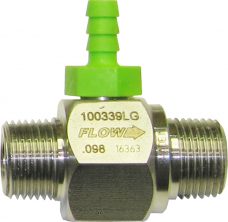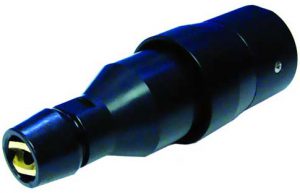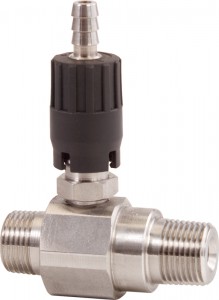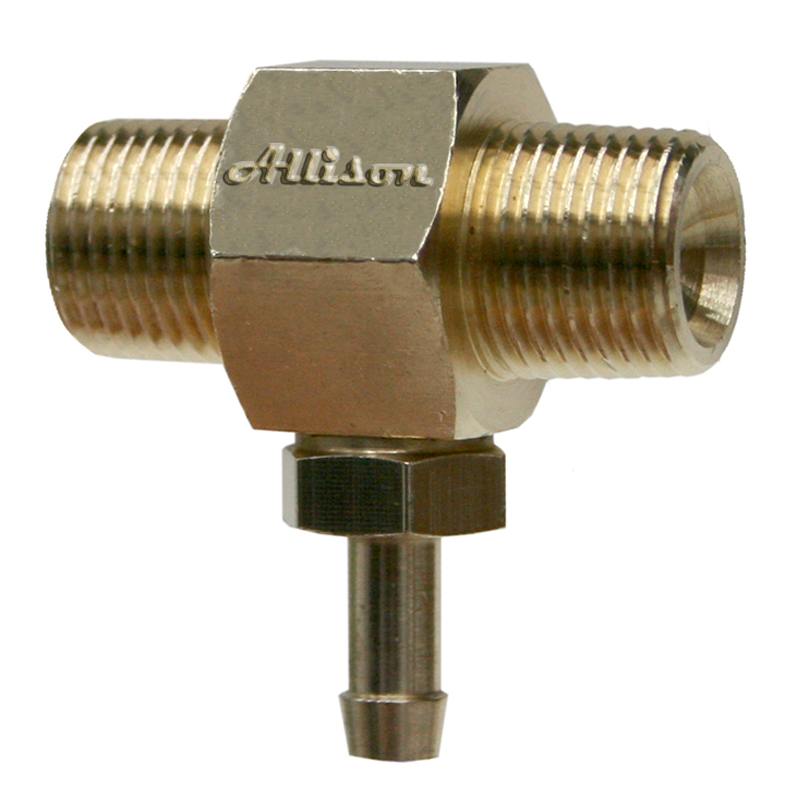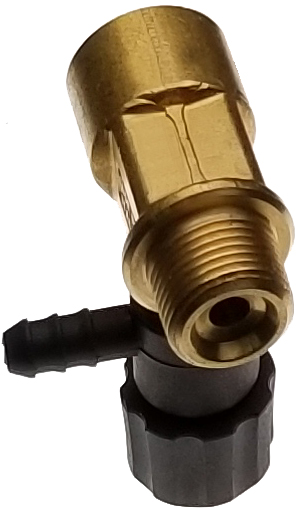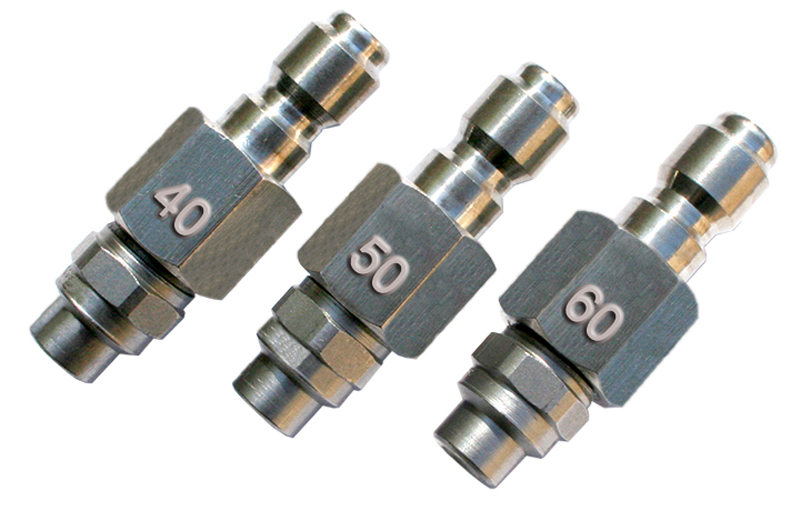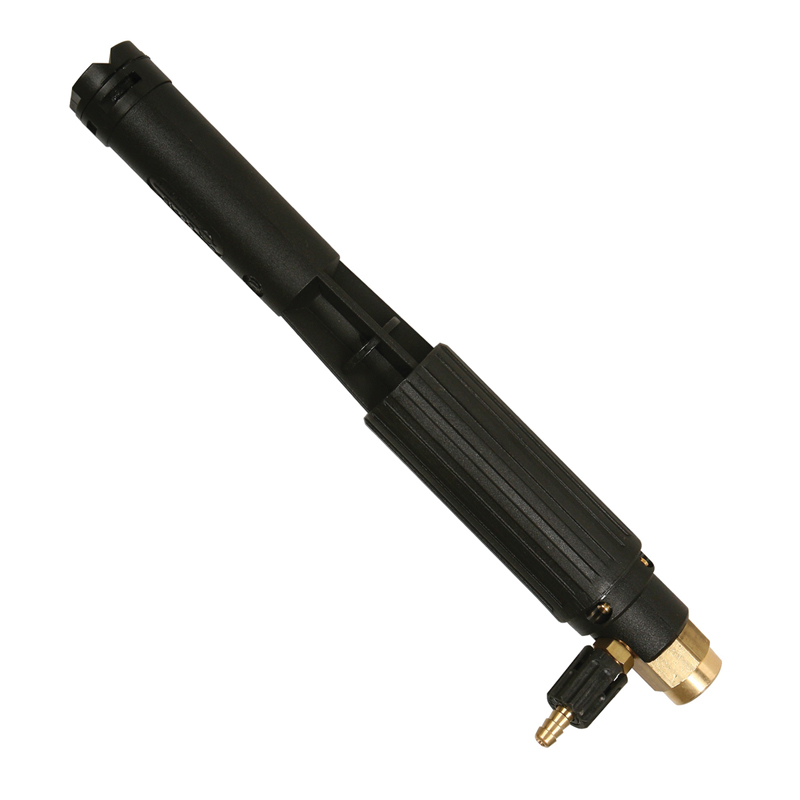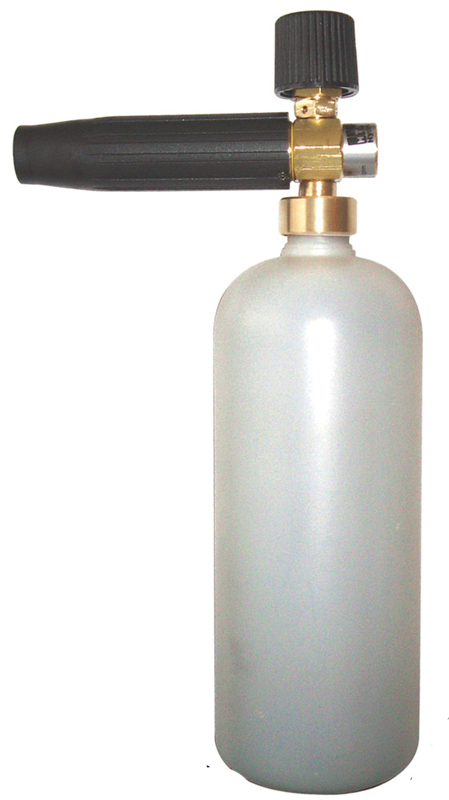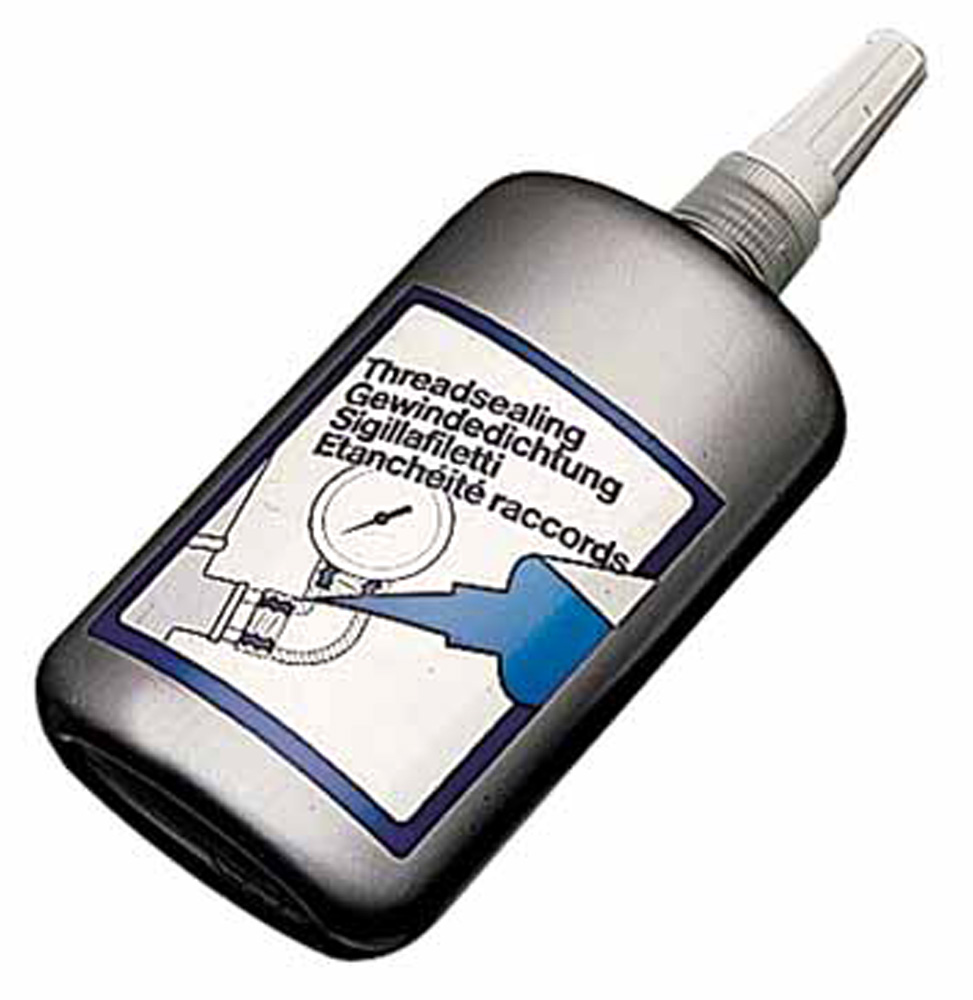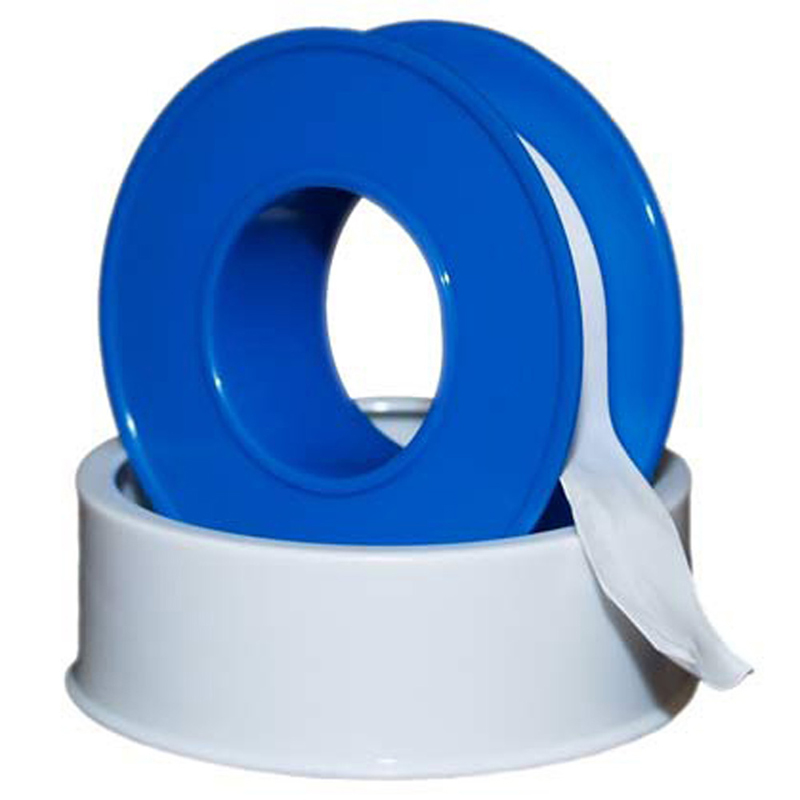Brass Chemical Injectors
Stainless Steel Chemical Injectors and Foamers

Testimonial: Roof Washing with Super Suds Sucker
"Since my gas powered roof pump was taken off my trailer for repair, I decided to test the DS Suds Sucker injector on some roof cleaning projects. This pic was a test section done @ a car dealer. Solution was shot up on roof with a shooter tip from the ground using 8 gpm machine. I love these injectors because they never disappoint. Have done 4 other roofs from the ground using the Suds Sucker with great results."Paul Whitney / PM Whitney Powerwashing www.pmwpowerwash.com www.facebook.com/pmwhitneypowerwashing
EnviroSpec ‘Super Suds Sucker’ Injectors have been
the Professional’s First Choice for over 25 Years!
The Industry’s Highest Drawing
Chemical Injectors!
Up To 30/50% Draw Rate
Comes standard with long lasting
Ceramic Chlorine Balls
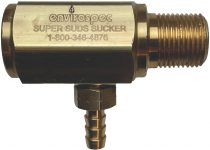
Part # 1964 –
Brass Injector
Each $89.97
The Industry’s Highest Drawing
Chemical Injectors!
Up To 30/50% Draw Rate
Comes standard with long lasting
Ceramic Chlorine Balls
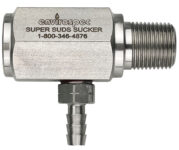
Stainless Super Suds Sucker
Part # 1964SS –
Stainless Steel Injector
Each $119.20
Super’ Suds Sucker
The Super Suds Sucker will draw up to 30%+ and will draw chemical with as much as 500′ of 3/8″ pressure washer hose attached. When hooked to the Chemical Induction Pump we have seen as high as 50% chemical draw rate.
There are 4 orifices that come with the Super Suds Sucker. The one marked #2 is for 4-6 GPM pressure washers, the #3 (already installed) is for 5-8 GPM, the #4 is for 8-10 GPM and the #5 for pressure washers over 10 GPM.
For pressure washers 4 GPM and under, you will need the #1 orifice part # 2108 – $5.22
Kits – ‘Super’ Suds Sucker
Part #: 1439 – Complete Repair Kit
1/4″ STAINLESS STEEL CHECK VALVE for
Chemical Injectors!
0.5 PSI Cracking Pressure!
Increase your Draw Rate
Replaces the Barb, Ball and Spring
1/4″ Stainless Steel Check Valve
Part # YCV14FSSLC
Brass Injector
Each SALE $39.97
General Pump YCV14FSSLC Check Valve
1/4″ Chemical Injector Stainless Steel Adaptor
Replaces the Injector Barb with 1/4″ MPT
Fits Most Injectors
Stainless Steel Adaptor
Part # 520353
Stainless Steel Chemical Injector Adaptor
Each SALE $7.97
1/4″ Barb X 1/4″ MPT Replacement Barb

1/4″ MPT X 1’4″ BARB
The chemical injector barb will NOT fit into the check valve, you will need a 1/4″ replacement barb
Part# 316-A14
Each SALE $3.97
Buy All Three and Save!
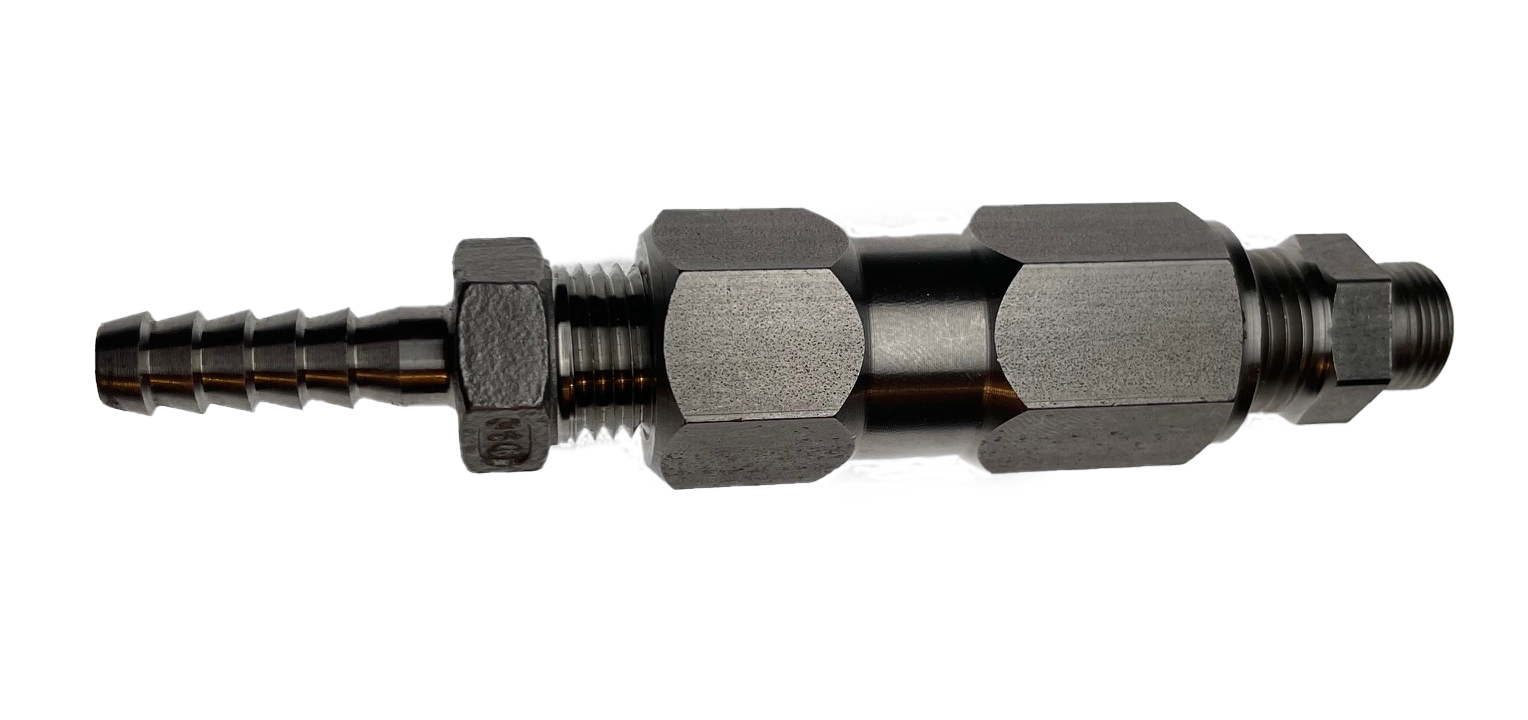
Buy all three
and SAVE
(unassembled)
Chemical Induction Pump
“Special-Build”
Chemical Induction Pump
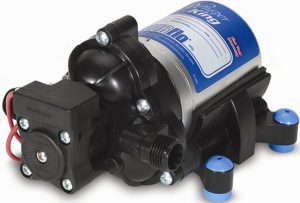
For years contractors have been asking for more chemical induction performance. Most injectors will provide up to 10-12% through the injector. Super Suds Sucker injectors provide up to 3 times that much but quite often this is not enough to satisfy the needs of the contractor who is up against a real tough job. To answer this call we have re-valved and balanced a popular ShurFlo pump that will answer the call. When you install this 12-V pump between the Chemical Supply and Injector and your injector will draw as much as 3 times the normal performance rate.
Part #: 5390CIS – Chemical Induction Pump
5.3 GPM @ 90 PSI with Viton Seals
Each $325.00
General Pump Injectors – Stainless – Up to 20%
Comes standard with a long lasting Ceramic Chlorine Balls
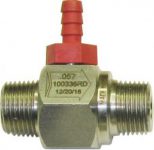
Part #: 1135 – 1- 2 GPM – NON-ADJ.
100336RD
Each $43.17
REPAIR KIT
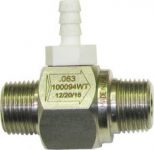
Part #: 1136 – 2-3 GPM – NON-ADJ.
100094WT
Each $43.17
REPAIR KIT
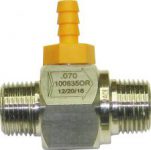
Part #: 1137 – 2-3 GPM – NON-ADJ.
100835OR
Each $43.17
REPAIR KIT
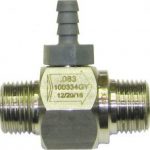
Part #: 1138 – 2-4 GPM – NON-ADJ.
100334GY
Each $43.17
REPAIR KIT
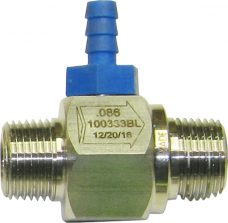
Double Gulp Suds Sucker
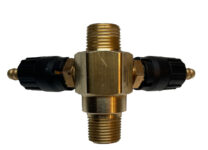
There are several metering ideas with the Double Gulp.
• Meter the same chemical through both valves for maximum injection.
• Meter two individual products at separate intervals.
• Meter a little bleach in with your detergent at the same time or
• Use one valve to introduce air into the system by ‘cracking’ the valve open without a chemical line attached.
Part #: DG1964 – Dual Injector Brass
ST-76 Foam Blaster
•Stainless Steel Injector Nozzle
•Wider Spray Angle
•For Applications Over 6 GPM
•Throws Foam 40 Feet
•Cover Large Areas
Each $320.76
Regular Price: $577.37Chemical Injector Bypass
Professional Chemical Injector Bypass Module
Can be used with the FlowPro

-Super Easy Connect & Disconnect With Quick Connects
*Chemical Injectors Sold Separately*
Part #: CIBPNI
3/8″ Chemical Injector Bypass – Brass & Plated Steel
Each $127.97
Chemical Injector Bypass
You’ve Asked For It…
Professional Chemical Injector Bypass Module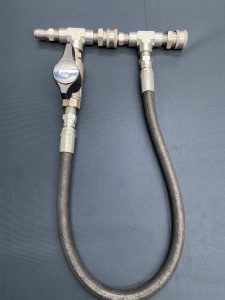
-Super Easy Connect & Disconnect With Quick Connects
-Super Suds Sucker (Brass: Part #1964, Stainless: #1964-SS)
Sold Separately.
Part #: CIBP
3/8″ Chemical Injector Bypass – Brass & Plated Steel
Each $89.97
3/8″ Chemical Injector Bypass – Stainless Steel
NEW
ST-161 Metering Valve
§ FOOD GRADE §
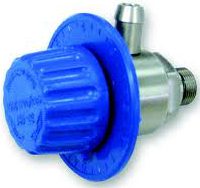
NOT A STAND ALONE ITEM – OLNY WORKS WITH OTHER SUTTNER EQUIPMENT
•Stainless Steel
•Adjustable
•212° F
Part #: 6150 – ST-161 Metering Valve
Each $133.89
Preset dosing valve and replace dial with Stop Nut so it can’t be readjusted!
Part #: 6151 – Metering Valve Stop Nut
Suds Suckers – Brass – Up to 27%
Up to 27% Draw Rate
Comes standard with
long lasting
Ceramic Chlorine Balls
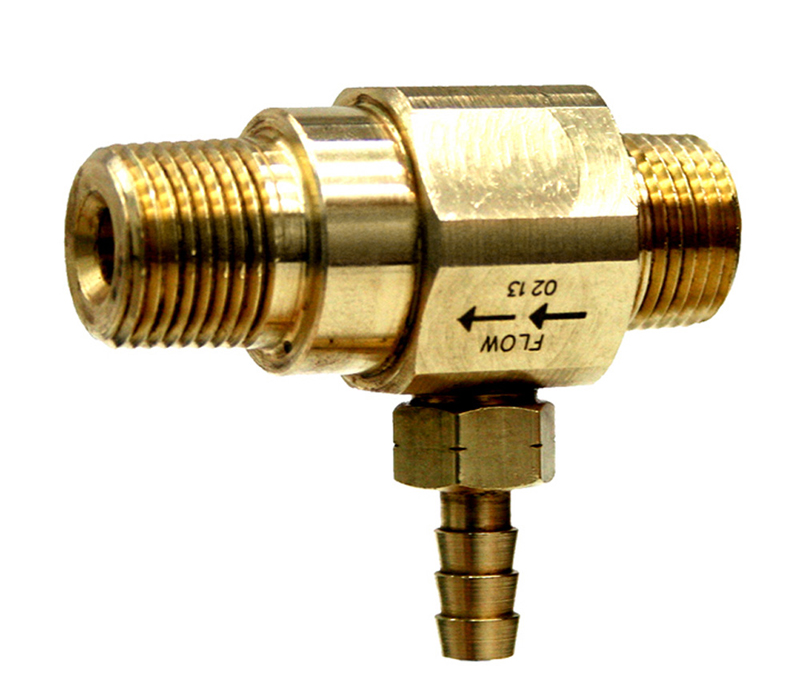
Part #: 1441 – 2-5 GPM – NON-ADJ.
Each $21.55
Dual Port – Stainless Steel
up to 30% Draw Rate
Draw from one chemical or two!!

3.0 to 6.0 GPM
Part #: 1139 – NON-ADJ.
Each $71.79
REPAIR KIT
Discontinued
Acid / Chlorine Shooter
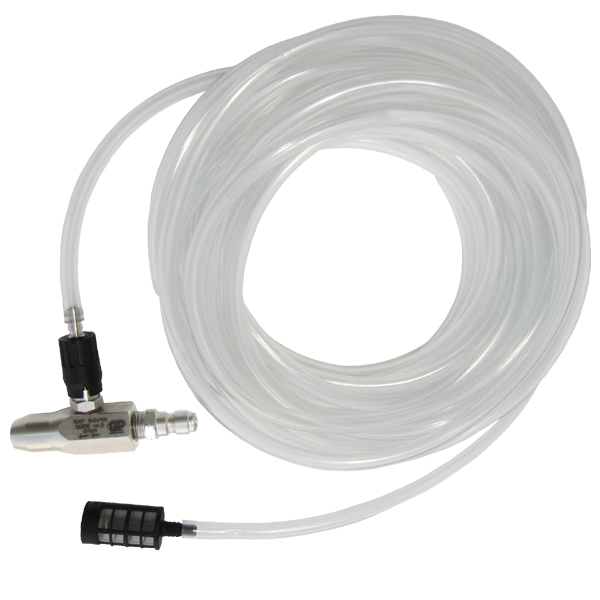
•Adjustable Chemical Feature
•Chemical Can Be Stopped
•Chemical Does Not Go Through Pump
•Attaches to QC On Lance or Extension Wand
•Ideally Suited for Acid & Chlorine Applications
Includes 30 ft. Hose, Filter and SS Nozzle
Part #: 4014 – Stainless, 5000 PSI, Size 6 Nozzle
Long Distance ‘Chem-Shooters’
ENVIROSPEC
CHEM-SHOOTER
Long Distance-High Impact
Chemical Nozzles
These long distance chemical nozzles have been tested at heights up to 37′. Now you can soap and clean from the safety of the ground. For best results use with one of the Super Suds Sucker chemical injectors.
Set includes 3-each high impact laser nozzles for both distance and high volume chemical. Nozzle Sizes are: 0040, 0050 & 0060
Part #: 5555
Each $27.97
Long Distance Adjustable Fan
Long Distance Adjustable Soap Nozzle
Everyone loves this item!
Goes from Fan Spray to Long Distance shooter (shoots up to 35′)
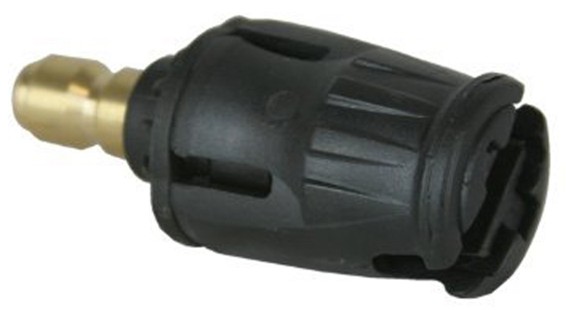
Foamers
NEW!
PF22 Super Foamer
For the Thickest Foam Ever…
The Foaming…’est’ Foamer Ever Built!
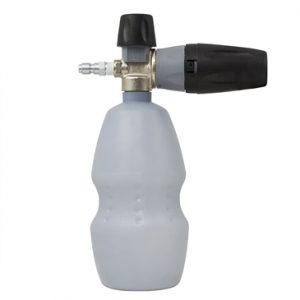
For use with Pressure Washers
Min – 1000 PSI – Max 5000 PSI
Min 1.4 GPM – Max – 5.3 GPM
Max Temp 140 F
Lafferty Hi-Volume Foamer
High Pressure
Chemical Injection
Designed to introduce detergents into the water system upstream from the pump at high pressure.
• Installs on the inlet side of the pump
• Includes hose and strainer
• Adjustable chemical flow
• Garden hose connection
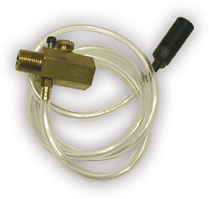
EnviroSpec’s Technical Library
Section: Chemical Injectors
Application Techniques
Pressure washing without chemical is like ‘smiling without any teeth.’ The result doesn’t look right. There are some jobs that are done without the use of chemical, but the vast majority of jobs require the use of chemical cleaning products to obtain the best result. The chemical can be applied with a direct spraying system that isn’t part of the pressure washer, and sometimes that is necessary because chemical must be applied at full strength. The more efficient way of applying chemical is with a chemical injector installed in the pressure washer stream itself. One reason this method is better is because it’s quicker. When using a direct spraying system, a electric pump or a compressed air sprayer, an average gallon per minute is anywhere from .5 to 2 GPM. Compare that amount of flow to the average pressure washer; say 4 to 6 gallons per minute. With anywhere from 2 to 6 times the flow, the speed of application is greatly increased. Another reason chemical injection is better is that it is all in one piece of equipment, and most times it can be controlled right at the pressure washer nozzle.
Section: Adjustable or Fixed Injectors?
There are pros and cons to both. Using a fixed type injector eliminates the adjustment knob. The adjustment knob on many injectors won’t stay where adjusted due to vibration. A fixed design is generally slightly less expensive. An adjustable injector allows the draw to be reduced. Reducing the draw of the detergent will save some money. Reducing the amount of detergent product reaching the surface that is being cleaned generally makes the job harder and reduces the quality of the end result. An adjustable injector can be operated fully open whenever detergent is desired, then it provides the option of using the pressure washer with low pressure and no detergent, by shutting the adjustment completely.
Section: Basic Function of Chemical Injectors
Downstream injectors operate using the venturi principle. This principle states that when water flows through a restricted area, its velocity increases and its pressure decreases. So a chemical injector has a restrictive orifice that the water stream is forced through. It also has a small port that chemical is drawn into because of the vacuum created. The vacuum is only created when there is little back pressure being exerted on the injector outlet port. So when the pressure washer is operated with a high-pressure nozzle, no chemical is drawn into the water stream. Operating with low pressure at the nozzle reduces pressure on the outlet port, and the suction draws the chemical into the water stream. A check valve keeps water from entering the chemical while the machine is operating at high pressure.
Section: Check Valve, Injectors
Downstream chemical injectors have a valve that keeps the water from entering the chemical pick up tube. It is a simple combination, starting from the injector body, of a spring, ball and o-ring. The ball and spring are housed inside a nipple or adjustment knob and nipple. The pressure of the water when the equipment is operated at high pressure overcomes the spring resistance and seals the ball against the o-ring. This prevents water from entering the chemical tubing. When the pressure is reduced at the outlet of the injector, the spring pushes the ball away from the o-ring seat and chemical path is cleared. The ball in this assembly can be made of steel, stainless steel, or ceramic. A ceramic ball is recommended if the injector is used with acids or caustics.
Section: Chemical (Soap) Nozzle Sizing for Injectors
A downstream chemical injector reacts to the back pressure exerted on its outlet port. Aside from hose length, the biggest factor affecting the back pressure produced is the actual pressure nozzle where the water flow finally emerges. When the equipment is operating with a high-pressure nozzle with a hole small enough to maintain a pressure of approximately 800 PSI or greater on the injector outlet, no chemical can enter the water stream. When a chemical or soap nozzle is used, and the pressure is reduced below this point, the ball can lift from the seat inside the injector, and allow chemical to flow. The lower the pressure, the easier it is for the chemical to enter the water stream. The larger the hole size on the chemical nozzle, the lower the pressure becomes. Common chemical nozzle hole sizes are 30, 40, and 50. The higher the water flow, the larger the hole needs to be to continue to operate at a pressure low enough for the chemical to be introduced into the water stream.
Section: Chemical Filter & Check Valves, Injectors
A filter should always be installed on the chemical end of the chemical tube. It keeps debris from entering the chemical tube and perhaps causing a blockage at the injector valve or nozzle. The chemical filter needs to be constructed of a material that is resistant to the chemical into which it is immersed. Plastics work well with most detergents and acids, however some acids, for example a strong Phosphoric, will damage them. Filters with stainless steel screens, which work fine with most detergents, don’t hold up well in some acids, an example would be Hydrofluoric Acid, which will completely dissolve the screen. When using products that may destroy a chemical filter, check often to determine if the chemical is affecting the filter. If deterioration is found, replace the filter with a filter constructed of a different material. Many chemical filters incorporate a check valve. The purpose of this check valve is to hold the chemical in the chemical tubing. This can be helpful if the tubing is moved from one container to another frequently. It keeps chemical from dripping out of the tube. If the chemical tube is rarely moved from container to container, use a chemical filter without a check valve. Check valves, while useful in some applications, can also be a source of trouble. Sometimes the ball in the valve will stick to the o-ring seat and not allow chemical to flow into the tube.
Section: Venturi Nozzle, Injectors
The chemical injector relies on the venturi nozzle to create a high pressure, fast stream of water inside the injector body. This nozzle must be properly sized to create the venturi action. The proper sized venturi nozzle will reduce the flow of water leaving the injector slightly, while allowing chemical to be injected. Installing a smaller venturi nozzle can help with chemical draw, but it also reduces water flow. One of the reasons chemical injectors wear out is that the venturi nozzle wears larger due to the water and chemical action. As the nozzle wears, the percentage of chemical drawn slowly lowers. This happens so slowly that the pressure wash operator may not notice it until the wash job becomes unacceptable, or difficult to accomplish.
Section: Chemical Viscosity for Injectors
The higher the chemical viscosity, or thicker the chemical is, the lower the draw rate of the injector will be. The chemical viscosity will increase if chemical is stored in open containers and evaporation occurs. Some thick chemicals need to be thinned prior to use to allow injection. Injection works best with chemical products that have a viscosity that is close to that of water.
EnviroSpec’s Technical Library
Section: Chemical Injectors
Article: Facts about Down Stream Injectors
There are many operational limitations that have to be considered to understand the function of the downstream injector in the field. To be successful working with a downstream injector it is important that you understand these operational factors.
Section: Downstream Injectors – Draw Rates
Advertised chemical draw rates are obtained under laboratory test conditions and cannot normally be obtained under field operating conditions. These draw rates are obtained with no back pressure on the injector outlet, meaning no hose, gun or nozzles are installed. The injector is operated with the exact water flow for peak performance, a short chemical tube with a low viscosity product, usually water being drawn. So it is unrealistic to expect field draw rates to be equal or even close to the advertised draw rate. These tests are conducted with the manufacturers efforts concentrating on getting the best possible result, because the average consumer is going to buy the injector with the highest advertised draw rate. So the injector with the highest advertised draw rate is probably the highest drawing injector, just don’t expect actual draw rates of more than 10 to 14%. And that draw rate will be reduced further with long lengths of hose, too small a soap nozzle, or mismatched water flow.
Section: Field Diagnosis and Repair – Chemical Injectors
Many variables affect the performance of a chemical injector. Practical field service involves the following steps. If there is no Chemical draw, first establish that the chemical container isn’t empty, or the chemical line hasn’t fallen out. Make sure the injector adjustment knob is open (turned out counterclockwise). Make sure the high-pressure hose isn’t too long. Replace the injector with the spare. If it works, go back to work. If that doesn’t work disconnect the trigger gun and nozzle from the hose. Test to see if chemical is drawn through the open hose. If it is, replace the trigger gun assembly and/or chemical nozzle. If the chemical line and filter weren’t replaced with the injector, determine if there is a blockage in them. Clear any blockage or replace the line or filter. Also check for loose fittings and cracks. If the injector is allowing water into the Chemical line replace the injector with a spare and go back to work.
Section: Installation of Chemical Injectors
The best place to install the injector is typically at the outlet of the pressure washer just prior to the high-pressure hose. If the equipment has a ball valve that allows the water to be turned off without shutting off the machine, be sure to install the injector after the ball valve to enable injector replacement without shutting off the equipment. Always install quick disconnects on the injector for quick change out. Always have a spare ready to replace the injector being used. Have quick connects, chemical tubing, and a filter already installed on the spare to reduce any potential down time. Most injectors have an arrow that indicates the direction the water flow should travel as it goes through the injector. Installing a chemical injector facing the wrong direction will definitely reduce its effectiveness.
Section: Pressure Hose Length for Injectors
High-pressure hose that is downstream of the injector exerts back pressure on the outlet port of the injector when water is flowing. The friction of the water stream contacting the inner tube of the hose creates the back pressure. The longer the pressure hose the more friction occurs and the greater the back pressure created. The pressure exerted on the outlet port of the injector adversely affects the venturi action of the injector. Because of this fact, the shorter the pressure hose is, the less back pressure is produced, and the higher the chemical draw will be. The pressure hose inner diameter also affects the back pressure created. Industry standard for high-pressure hose is 3/8″ inner diameter. In some cases a ¼” I.D. hose is preferred because it is lighter. Remember that the friction of the water going through a smaller hose will create more back pressure and very likely affect the injector chemical draw. A larger ½” I.D. hose can be helpful when it is necessary to run a long high pressure hose while still being able to draw chemical. The drawback is the hose weight. Most downstream injectors work the best in the field when used with 50 to 100 feet of 3/8″ I.D. pressure hose. Some will continue to draw chemical at 150 feet of hose, most will no longer draw with 200 feet of pressure hose. As the hose length increases, the percentage of chemical drawn into the water stream decreases. Because of this, in situations where a high percentage of chemical draw is important to the result of the wash job, a shorter hose is beneficial. A trick of the trade when a long hose is needed along with downstream chemical injection is to move the chemical injector itself down line in the high-pressure hose. The pressure on the injector outlet port is what affects the chemical draw, so as long as the hose in front of the outlet is kept to a minimum, the hose behind the injector won’t inhibit chemical draw. There is a limit to this trick however. If enough hose is installed behind a downstream injector to actually reduce the water flow to the point where there isn’t sufficient water to create the venturi action in the injector body, then injection won’t occur.
Section: Shop Diagnosis and Repair of Chemical Injectors
The debate will continue as to the practicality of repairing chemical injectors. When a downstream injector can be purchased for less than twenty dollars, is it worth rebuilding it? Most rebuild kits contain a ball, spring and o-ring; some also have the nipple or adjustment knob. Most don’t contain a replacement venturi nozzle. The more the complete injector costs, and the cost the rebuild kit, are determining factors in deciding this issue. If the injector isn’t producing any chemical, first eliminate the surrounding factors as possible problems before rebuilding the injector. Inspect, clean and/or replace the chemical tube, fittings and filter. Test without the trigger gun and nozzle. Sometimes there can be something in the trigger gun or nozzle that isn’t allowing the pressure to be reduced enough for the injector to function. Isolate where the problem is and replace the part. This test can also determine if because of venturi nozzle wear the injector is worn to the point where it won’t function well enough to be used anymore. If available, replace the venturi nozzle. Some can be threaded out. Some are simply pressed into a cavity in the injector body. Replace the quick connects if they are worn. If the injector is allowing water into the Chemical Line, first unscrew the nipple or adjustment knob from the injector body. If the spring and ball appear to be in good condition, check to see if the o-ring is out of place. If it is reinstall it and reassemble. If the o-ring is missing or damaged, or if the ball or spring is not in new condition, rebuild the injector. To rebuild the injector, unscrew the nipple or adjustment knob from the injector body. Find and replace the spring, ball and o-ring. Install the components; working furthest away from the injector body first, the order is, o-ring, ball, and then spring. Use pipe thread sealer on the threads of the nipple or adjustment knob, and then thread back onto the injector body.




